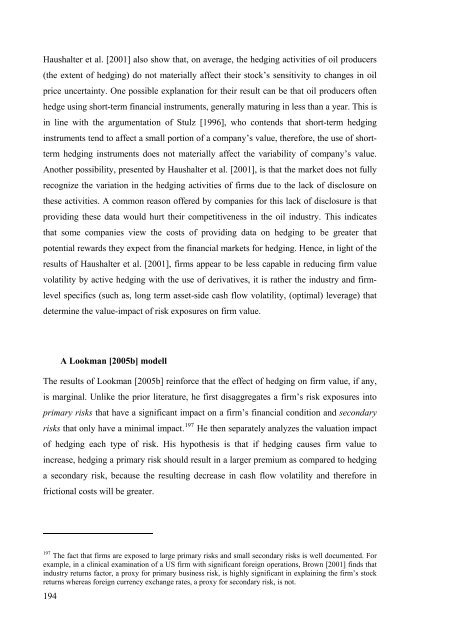értekezés - Budapesti Corvinus Egyetem
értekezés - Budapesti Corvinus Egyetem
értekezés - Budapesti Corvinus Egyetem
You also want an ePaper? Increase the reach of your titles
YUMPU automatically turns print PDFs into web optimized ePapers that Google loves.
Haushalter et al. [2001] also show that, on average, the hedging activities of oil producers<br />
(the extent of hedging) do not materially affect their stock’s sensitivity to changes in oil<br />
price uncertainty. One possible explanation for their result can be that oil producers often<br />
hedge using short-term financial instruments, generally maturing in less than a year. This is<br />
in line with the argumentation of Stulz [1996], who contends that short-term hedging<br />
instruments tend to affect a small portion of a company’s value, therefore, the use of shortterm<br />
hedging instruments does not materially affect the variability of company’s value.<br />
Another possibility, presented by Haushalter et al. [2001], is that the market does not fully<br />
recognize the variation in the hedging activities of firms due to the lack of disclosure on<br />
these activities. A common reason offered by companies for this lack of disclosure is that<br />
providing these data would hurt their competitiveness in the oil industry. This indicates<br />
that some companies view the costs of providing data on hedging to be greater that<br />
potential rewards they expect from the financial markets for hedging. Hence, in light of the<br />
results of Haushalter et al. [2001], firms appear to be less capable in reducing firm value<br />
volatility by active hedging with the use of derivatives, it is rather the industry and firmlevel<br />
specifics (such as, long term asset-side cash flow volatility, (optimal) leverage) that<br />
determine the value-impact of risk exposures on firm value.<br />
A Lookman [2005b] modell<br />
The results of Lookman [2005b] reinforce that the effect of hedging on firm value, if any,<br />
is marginal. Unlike the prior literature, he first disaggregates a firm’s risk exposures into<br />
primary risks that have a significant impact on a firm’s financial condition and secondary<br />
risks that only have a minimal impact. 197 He then separately analyzes the valuation impact<br />
of hedging each type of risk. His hypothesis is that if hedging causes firm value to<br />
increase, hedging a primary risk should result in a larger premium as compared to hedging<br />
a secondary risk, because the resulting decrease in cash flow volatility and therefore in<br />
frictional costs will be greater.<br />
197 The fact that firms are exposed to large primary risks and small secondary risks is well documented. For<br />
example, in a clinical examination of a US firm with significant foreign operations, Brown [2001] finds that<br />
industry returns factor, a proxy for primary business risk, is highly significant in explaining the firm’s stock<br />
returns whereas foreign currency exchange rates, a proxy for secondary risk, is not.<br />
194
















